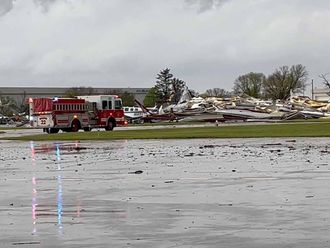MEXICO CITY: It has the drugs and distribution system of a traditional cartel — and it has the modern weapons and audacity of an army. After attacking federal forces, downing a military helicopter and shutting down streets in Mexico’s second-largest city last week, the New Generation Jalisco cartel is now the main enemy in the country’s fight with drug cartels.
In just a few years, New Generation has grown from being an offshoot of the powerful Sinaloa cartel to one of Mexico’s strongest criminal groups in its own right, according to the US. Treasury Department, whose Office of Foreign Assets Control maintains a “black list” of drug trafficking organisations.
Its quick rise reflects a rapidly changing organised-crime landscape in Mexico as the government targets top leaders of established cartels. More than any other criminal group, New Generation has taken advantage of the government’s top-capo strategy, strengthening and grabbing territory from other cartels as they are weakened.
“You’re talking about a powerful, large organisation with grand logistics, well-made structures, a strong group of assassins, and dedicated and qualified people with high-calibre weaponry,” Guillermo Valdes, a security expert and former director of the Mexican intelligence agency, told The Associated Press. “It’s a new cartel, a second generation born in a restructuring process.”
The strategy of hitting top leadership began in 2006 under President Felipe Calderon and has continued under his successor, Enrique Pena Nieto. As a result, large organisations have been fragmented, leaving smaller, leaderless groups to fight among themselves over control of local organised crime activities and drug-smuggling routes to the north.
When Calderon was in office, there were five major cartels. Today, the Mexican attorney general lists nine major groups and 43 smaller factions.
New Generation has its origin in that fragmentation.
While it has operated for years, it surged in public notoriety last week after it waged brazen attacks in and around Guadalajara, a major technology and manufacturing hub and the capital of Jalisco state, which is a popular retirement spot for US and Canadian expats. But the city, some 290 miles (460 kilometres) northwest of Mexico City, is also where Mexico’s largest drug cartels were born.
Leaders of the original Guadalajara cartel were captured in the 1980s, provoking a surge in what Valdes calls the first generation of cartels, many of which still exist, including Sinaloa, Beltran Leyva, Gulf, Zetas and Juarez cartels. But hits on their leaders have left all but Sinaloa as just remnants of their former selves.
In little more than a year, the government has arrested Sinaloa’s Joaquin “El Chapo” Guzman, Beltran Leyva’s Hector Beltran Leyva, Juarez’s Vicente Carrillo Fuentes, Knights Templar’s Servando “La Tuta” Gomez, and the Zetas’ Omar Trevino Morales. It killed Knights Templar leader Nazario Moreno.
Such blows have allowed New Generation to grow. Jalisco Gov. Aristoteles Sandoval told Mexican media Wednesday that he warned the federal government more than a year ago that its attacks on a rival cartel, the Knights Templar, would strengthen New Generation but the reaction by authorities was insufficient.
“The attorney general, overall, made three changes in his delegates but honestly with zero results,” Sandoval told Universal television. “In this matter, from the attorney general there was nothing. Same with the federal police. Zero.”
According to the US. Treasury Department, New Generation is mainly devoted to trafficking cocaine and methamphetamines. Working with an associated group known as Los Cuinis — a phonetic rendering of “The Queenies” — the cartel has a presence in at least eight of Mexico’s 31 states and connections in the US, Latin America, Africa, Europe and Asia. A US indictment in 2013 said New Generation leader Nemesio Oseguera and his brother-in-law, Cuinis leader Abigael Gonzalez Valencia, move multi-ton quantities of cocaine from South America to Mexico and facilitate its transport to the US, earning at least $10 million a year.
The indictment charged them with running a criminal enterprise and conspiracy to distribute cocaine and methamphetamine.
New Generation has its origin in the now-defunct Milenio cartel and it later operated as an affiliate of Ignacio “Nacho” Coronel, the Sinaloa cartel leader who was responsible for the group’s methamphetamine division.
When Coronel was killed in a July 2010 federal operation, the New Generation fragment started to grow. One reason, some speculate, is that Oseguera, alias “El Mencho,” was very close to Coronel and may have inherited his contacts. He also maintained a good relationship with the Sinaloa cartel. Others say New Generation has been able to take advantage of suppliers and distributors who have worked in the area for decades, even predating Coronel.












